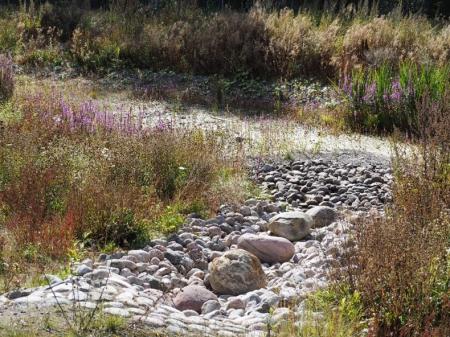
Area characterisation:
Alluvial meadow’s area is ca. 500 m2. Meadow slope varies from 1:10 to 1:20 and the meadows are occasionally flooded depending on the severity of the storm. Alluvial meadow was grown from a commercially available seed mixture of domestic alluvial meadow plants sown on a 150 mm thick growth medium layer.
Objective:
Space for retention of the urban runoff in the times of heavy rain to complement the measures for enhanced stormwater quality and quantity management in the Vuores area. Vegetation is selected from the local species to support biodiversity, including perennials suitable for wet conditions. Additionally, the area is equipped with the information sign introducing the NbS and its functions.
Potential impacts/benefits:
Flooding indicators included those related to surface runoff, time to flood peak and flood peak height (or, water depth), and they were evaluated with the help of modelling. Retention pond and alluvial meadows in Vuores demonstrated 94% and 88% reduction in surface runoff and a 86% and 90% reduction in water depth for a 10- and 100-year return periods respectively when compared to no NbS situation. The retention pond and alluvial meadows NbS had a very notable effect in decreasing the runoff coefficient, performing better than the biofilter even during high intensity precipitation events. The effect will not be so prominent if the pond is partly filled before the storm event. The retention pond and alluvial meadows scenario had the opposite effect on delaying the flood peak time, accelerating flood peak occurrence (-35% and -9% for 10- and 100-year return periods), however discharge values were greatly diminished.
In the survey regarding the Vuores stormwater management system, the respondents rated highly such aspects as easiness of reach, aesthetics and feeling of connectedness with nature. Aspects related to increased physical activity, extending time spent outdoors or making a longer route received score from 3.6 to 4. In total 93% of Vuores residents perceived the stormwater management system as improving their living conditions.
Transferability of result:
The vegetation mix was selected from local Finnish plants such as Filipendula ulmaria, Iris pseudacorus, Lythrum salicaria and Myositis scorpioides. In Tampere, alluvial meadows are replicated in new residential areas around retention ponds and stream restoration projects.
Lessons learnt:
The decentralised, hybrid (grey, blue and green infrastructure) stormwater management system of Vuores performs well for retention and purification of urban runoff. However, interpretation of monitoring data was challenging at times due to the complexity of the system. The acceptance of “new urban aesthetics” such as meadows and bushes instead of neat grass was challenged by the citizens' understanding of the system function and need.
Organisations:
City of Tampere, https://www.tampere.fi/en
Ramboll, Finland, https://fi.ramboll.com/
VTT Technical Research Centre of Finland Ltd., https://www.vttresearch.com/en
NBS goals:
- Developing climate change adaptation
- Improving risk management and resilience
- Urban regeneration through nature-based solutions
- Multi-functional nature-based watershed management and ecosystem restoration
NBS benefits:
- Flood peak reduction
- Increase infiltration / Water storage
- Increasing infiltration
- Reduce load to sewer system
- Reduce run-off
- Increase Biodiversity
- Changing image of the urban environment
- Increase accessibility to green open spaces
- Increase awareness of NBS solution & their effectiveness and co benefits